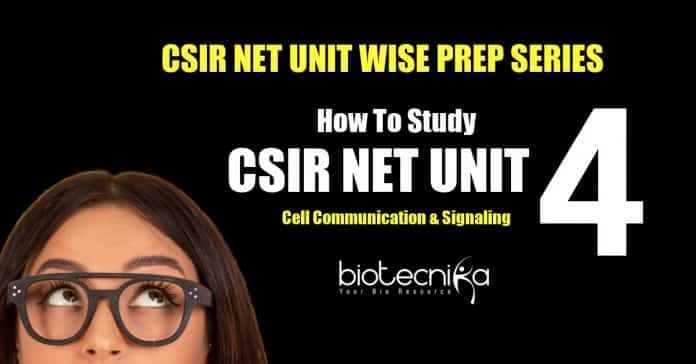Cell Communication & Signaling CSIR NET Unit 4 Important Topics
CSIR NET Exam: How to Study Cell Communication and Cell Signaling Effectively
CSIR, the dream exam for thousands of Life science students in India, who have decided to build a magnificent career in the field of research or academics.
The CSIR exam is conducted by the National Testing Agency usually, twice a year, in June and December.
“You can’t build a great building on a weak foundation”
You need to design a sturdy and considerate strategy to work on and prepare for the exam leading you on the path progressing towards the fulfillment of your dream.
After you have already enlisted the important dates, verified the eligibility criteria, completed the application procedure, gathered an idea about the pattern of examination, and searched for the syllabus content as per your subject, it is time to develop an obstinate study plan.
If you are all set for writing the CSIR NET Exam foremost, you must analyze the syllabus. List out a comparative analysis of your depth of knowledge from your educational background with the syllabus content of the concerned stream. Accordingly, start the preparation to progress towards your anticipated career.
Following are the general tips to analyze the activities and efforts that you must execute in order to achieve your goal because unless you have an appropriate preparation strategy, it is tough to crack the CSIR NET Exam
To Initiate your preparation!
Clearly understand the exam pattern and focus on the score to aim at the exam qualification, which you can simply do by analyzing the cut-offs from the previous year’s examination results.
Review the Complete CSIR NET Syllabus (as per your chosen subject) and enlist up all the topics on a paper.
Seek out the best CSIR NET Study Material, Standard reference Books, and Coaching assistance (If you are pursuing it)
How to create the right study plan?
It must be realized; all human beings possess unique ways of perceiving things so no single strategy is able to serve every student. This necessitates the requirement of developing an innovative better method of learning exclusively for you.
“Trust yourself because no one knows you better than yourself”
You may consider the following points while working out the best methodology which may ease your path in landing up at your destination
- Look for the important topics instead of learning the whole syllabus because 100 percent syllabus coverage doesn’t ensure 100 % success, you have to strive for excellence in a few units which you feel are your strength rather than getting yourself exhausted covering the whole syllabus.
- If you feel studying for prolonged hours can guarantee your success story, then you must reanalyze because it has been proven that studying in short patches taking decent breaks in between improves the efficacy of understanding and learning things.
- Work like a detective and check for the best productive hours out of your day. Although that may differ for each individual but utilizing morning hours is recommended to cover the most challenging topics from the syllabus.
- Revision is the most crucial part of the preparation, so you must keep running the revision cycles for the topics completed during the most prolific duration of the day.
- Mood of an individual conducts in a nonlinear way and it is dependent on multiple small objects from our lives. Conclusively you need to keep yourself in high and happy spirits by putting you in delighted and buoyant situations all during the preparation.
The entire syllabus of the CSIR NET Exam comprises 13 units in total with multiple subunits in each unit.
Since all the units are so immense with elements up to gravity in each topic it may not be feasible for any individual to prepare all the 13 units. It is always advised to be comprehensive in those units which are relevant according to the academic background and interest of the candidate and thus skip others.
“Unit 4” An important and interesting unit from the CSIR syllabus!
Cell Communication & Signaling CSIR NET Unit 4
Among all the units, unit 4 which covers Cell communication and cell signaling is one such vital unit that is suggested not to be skipped while making the selection of the units as part of your study plan.
Let us Calculate the approximate weightage of this unit!
Based on the weightage of different topics and analyses of the types of questions asked previously it has been revealed that around 7- 8 questions are asked in part B and approximately 9 to 10 questions can be asked in part C that makes a total of around 16 – 18 questions from this unit, a significant number from examination point of view.
Let us have a glimpse of the layout of the first subtopic from “Unit 4” i.e. Host-Parasite Interaction!
Topics that must be emphasized from this subunit are types of diseases: bacterial and viral, food and water-borne, airborne and their causative agents, pathogens, and their corresponding host. All the general definitions regarding parasites, host, and host-parasite relationships are important to be understood intensely. Go through these basic terms precisely like primary host, secondary host, paratenic host, reservoir host, vector, carrier, colonization, etc.
How to strengthen command over this subtopic?
Make a table and enlist all the common and uncommon human diseases (don’t skip COVID19-the most recent pandemic caused by coronavirus ), mention the names of the causative agents in the next column followed by penning down the hosts in the subsequent column. You may paste this table somewhere near your study table for regular revision.
Let us head towards the most crucial subtopic of this unit 4B – “Cell signaling”
It may sound amusing, but true, Cell signaling is indispensable to a living cell so is this topic unavoidable for a student. Every year questions appear from this topic bolstering the need to understand the signaling events in depth. The best part is this topic is pretty riveting to be learned. Firstly, you must comprehend what Cell signaling means? Why is it needed in the cell?
In your childhood, have you ever experienced rotating the television antenna to attain the exact orientation where the television set detects and picks up the transmitted signals and starts telecasting it?
Well, then you may relate this situation where the living cell acts like a television set which requires the right set of information to respond in various ways leading to the progression and occurrence of numerous biologically significant events.
So, to receive those signals the receptors (working analogously to antennae) are located on the cell surfaces or less often in the internal of the cell. You must fetch every aspect about the various receptors available on the cell surface bringing different cell responses like G-Protein Coupled Receptors and Receptor Tyrosine Kinases moving into how they are associated with MAP kinase pathway, JAK-STAT pathway, Wnt pathway, Hedgehog pathway, and ephrin signaling pathways.
The names and mechanisms of all the secondary messengers like cAMP, cGMP, phosphatidylinositides, calcium ions, NO, etc. must be learned. You will find, all these pathways are correlated in terms of the common mechanisms and role of secondary messengers but even then how magnificently and precisely they lead to specific spatial and temporal responses may remain a hallmark for a particular type of cell or tissue. That proves the peerless strength of nature. It would be enlightening to learn how the regulation of these pathways controls the glucose level in blood post-meal, our ability to smell or taste our food, or our vision in light or dark. Do not skip to include the effect of toxins and inhibitors on these signaling pathways.
Can cell commit suicide and what makes it do that?
Apoptosis which makes a cell undergo programmed cell death is really a fascinating topic to be discovered. You will come across how a cell itself does all the preparations to die which may be a part of the regular process during embryonic development or in case the cell becomes a threat to the body itself, in cancer, or during an immune response to any virus. In addition to exploring the characteristics of the apoptotic cell, you must conceptualize the- two pathways of apoptosis, the extrinsic pathway and the intrinsic pathway, the role of “caspases”, proteases which trigger most of the changes observed during cell death, types of caspases, bcl-2 family proteins which include pro-apoptotic members, antiapoptotic members and BH3 only proteins involved in apoptotic regulation.
Flowcharts and tables are going to act as a panacea to memorize the key concepts!
Now you must be wondering how difficult it would be to remember these pathways, so here is the solution to this muddle. Design neat and expressive flowcharts on your own, highlight all the receptors, enzymes and kinases, and the targets involved in a cell signaling pathway. You can also construct tables with names of the receptors, effectors, secondary messengers, accessory proteins like calcium-binding proteins, and corresponding targets i.e. biological processes which these processes will be controlling.
Let us crack with subtopic 4C – “cellular communication”!
Cell Communication & Signaling CSIR NET Unit 4 Important Topics
Have you ever wondered how cells remain intact together to build up strong palisades on and across the tissues? Imagine the cement which is applied to tether the bricks together while building up a wall. Comparably cells carry adhesion molecules supporting them to create robust barriers to the extracellular environment at the same time making junctions that aid in the cell to cell communications.
In this unit four major types of cell adhesion molecules (CAMs), cadherins, selections, integrins, and immunoglobulin superfamily members are the highlights. Their detailed structure, differences in interaction patterns, and relation to various types of junctions are paramount of study. Cell-Cell interaction and cell-matrix interactions both are the foundation of the salient processes going in the body like cell division, differentiation, motility, or apoptosis. Consequently, distinct junctions like adherens (Zona adherens), desmosomes (Macula adherens), tight Junctions (Zonulae occludens), focal adhesions, hemidesmosomes, and gap junctions keep the cellular integrity intact along with maintaining the state of homeostasis in the cell. Besides that, insight into components of extracellular matrix-like collagen, laminins, fibronectin, proteoglycans should be considered and studied thoroughly.
Cellular communication can augment your communication to a good examination score!
Certainly, it is one of the scoring topics from the syllabus which can leave you earning a good score indeed. Assuredly, you would not like to let off with that.
Let us visualize the pattern of questions that could be asked from this unit!
You may find direct short questions related to the diseases and their pathogens, characteristics of the molecules that are part of the cell signaling events, secondary messengers, or apoptosis in Part B.
You could be asked a long statement question as to which of the following events is CORRECT or INCORRECT, TRUE, or FALSE designed on the properties of cell adhesion molecules and junctions. Do not skip to carefully look at whether the correct statements are being asked or the opposite. These are usually the combination of the topics from all the subunits which necessitates preparing all the subunits of the unit being considered.
In part C, you may uncover long questions in the form of the following which are probably the easiest to answer. Targeting the qualifying marks and skipping the unsure questions is the key to avoid negative scores and there these types of questions are a big relief. From this unit, this pattern can be undertaken to create questions based on the pathogens and corresponding ailments, characteristics, and location of various cell adhesion molecules, junction properties, the role of various apoptotic factors but whatever comes your way, believe it you can easily solve this type of question if you know at least one right match in the options in most of the cases.
Look for more Graph-based questions in part C which are usually constructed merging two concepts together like cell cycle and apoptosis. Primarily the information is provided in the question itself and you are expected to just visualize and analyze the graph taking that knowledge into account. Such questions can ease your way towards getting some good score in Part C. By accepting and attempting such questions, you can turn this statement realistic which says “Accept the challenges so that you can feel the exhilaration of victory” since most students skip graph-based questions and you can stand unique nailing them down with your accurate approach.
Many people wait around for the right time to come, having the least idea that there is no such thing as the right time. It is not actually the time which is right or wrong. But your attitude towards seizing the time and turning it accurately.
These tips will assist you to correctly confiscate this topic – Cell Communication & Signaling and will certainly contribute to easing your excursion towards cracking CSIR.
Read Also On CSIR NET Exam Unit Wise Important Topics:
- CSIR NET Unit Wise Prep Series: How To Prepare CSIR NET Life Sciences UNIT- 1
- CSIR NET Unit Wise Prep Series: How To Study Important Topics Of CSIR NET Unit-2
- Check CSIR-NET EXAM UNIT 3 Smart Preparation Tools
Author: Dr. Nidhu Hukku
Cell Communication & Signaling CSIR NET Unit 4 Important Topics – How To Study.







































